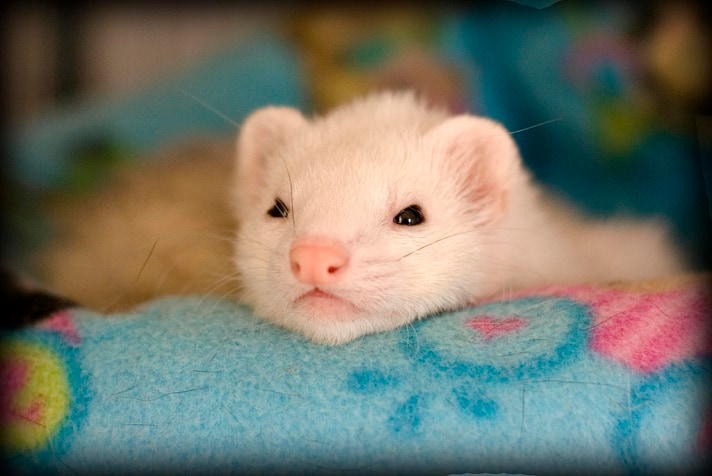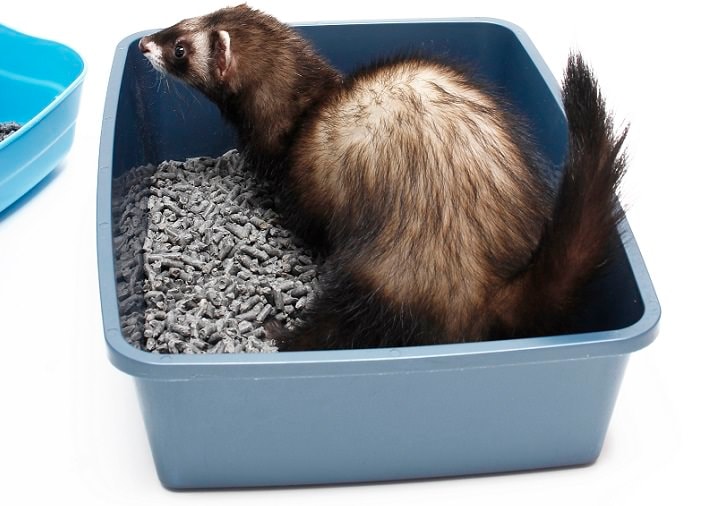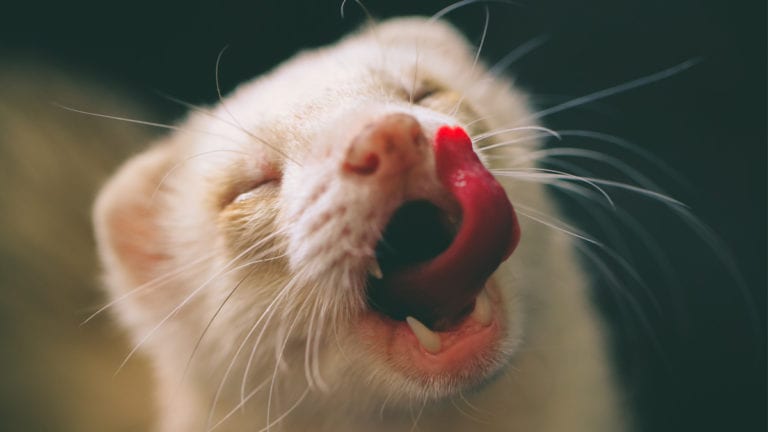If your ferret hurt its leg, how would you react? Would you speed it to the veterinarian right away? What if the ferret was crying in pain? Would you now consider the injury more of an emergency? A study published a few years ago suggested human beings are hardwired to interpret crying as a call for help. Apparently, crying makes any pain or distress seem more of an emergency — regardless of degree of injury — spurring us to intervene.
Human reaction to crying is important to ferret owners because ferrets are animals that generally react quite stoically to pain and distress; they hide their symptoms. Adult polecats, which are probable ancestors of ferrets, are solitary animals, so most vocalizations are essentially superfluous, including calls for assistance. Regardless of reason, most ferrets rarely vocalize pain or distress — at least after the initial injury. This means a ferret’s response to pain or distress is generally very little response at all.
Quantifying Ferret Pain And Distress
It is impossible to know exactly how much a painful injury actually hurts a ferret. It is the same with humans; people react differently to seemingly identical injuries. Pain tolerance is a combination of factors, such as levels of excitement, fear or anger. My experiences with ferrets suggest they exhibit very high pain tolerance, but tolerance is not an absence of pain. Without evidence or a means to quantify species differences, the only safe assumption is to presume ferrets feel pain similar to humans.
Anyone who has picked up a frightened ferret knows they feel distress, but few studies have qualified or quantified it in any animal. Identifying ferret distress is quite difficult; it’s very hard to identify in humans — and we can talk! Ferret distress is relative to ferrets, so things we would not normally recognize as being stressful can seriously bother a ferret. Distress in a ferret is often hidden behind the world’s best poker faces; they have tells, but you have to be a good observer.
Causes Of Ferret Pain And Distress
Causes of ferret pain are innumerable; virtually anything that can cause pain in humans will likewise hurt a ferret. Most people recognize surgery as very painful. Moderate to severe injuries usually cause a cry of agony, but afterward the ferret can be as silent as a grave — even with mortal wounds. Physical activity does not disprove pain; there are numerous reports of injured ferrets continuing to play until they collapsed. If you suspect something is hurting your ferret, you are probably correct, so — until proved otherwise — assume all injuries are painful.
It’s safe to presume bruising, broken bones, cuts, swellings, loss of function and the like are painful. Dental disease, fracture, worn enamel, damaged teeth or dental abscess can result in severe pain. Metal cage floors can hurt sensitive footpads, especially with older ferrets. Adrenal ferrets can have dry, itchy skin that is at least uncomfortable. The list is infinite; the point is that pain can exist even if cries don’t persist.
Distress in ferrets is even more difficult to identify. Part of the problem is that ferrets are very adaptable, so it is easy to assume adaptation to stress means distress has faded. Studies of stressed children have shown they can still have elevated levels of stress hormones after considerable adaptation. In other words, they adapt to stressful situations, but remain distressed. A study in lab animals suggested the only accurate means of identifying distress is by testing for stress hormones. Complicating things is that ferrets are individuals with a particular set of likes and dislikes. A dozen ferrets might not mind the light, but the single ferret that does will be in constant, yet hidden, distress.
Like pain, causes of distress are innumerable, but most relate to a ferret’s inability to perform instinctual behaviors. A lack of basic comforts, such as warm bedding, clean water and nutritious ferret food are easily recognized as distressful. Overcrowding, noise and light pollution, aggressive pets, rough handling and confinement can all be significant stressors. Play biting, exploration, corner pooping, or carpet and plant digging — strong instinctual behaviors — can cause chronic distress if punished or prevented. A ferret may want to live alone, or a group might not want a new member. A lack of a dark sleeping den and boredom are distressing to most ferrets. Until routine tests for elevated stress hormones are done, the only safe bet is to presume that ferrets are stressed when forced to live in ways inconsistent with their natural history. In short, if you don’t treat a ferret like a ferret, it is usually distressed.
Signs Of Ferret Pain And Distress
Specific signs of pain and distress largely depend on the ferret. One ferret might bite, another might whimper and a third may barely react when hurt. It is not so much what the ferret does as it is a change in behavior. In other words, while ferrets stoically won’t show pain or distress by crying, they often signal pain with behavioral changes. If your ferret doesn’t typically bite, a serious chomp is probably a signal of pain or distress.
While not set in stone, my experiences suggest traumatic injuries cause sudden or profound changes in behavior. As diseases progress, they generally result in gradual changes in behavior. Unfortunately, distress can cause either sudden or gradual behavioral changes; it just depends on the situation and the ferret.
My ferret Maizy is generally a hider, so when she gradually starting becoming aggressive toward other ferrets, I immediately suspected adrenal disease. When Scout — a dedicated explorer — suddenly started hiding, examination showed a broken canine, probably from a fall. Belle’s stress-related aggression evaporated when I housed her alone. Bear became very subdued and had a mild limp; X-rays showed he had a fractured hip. In each case the signs were not whimpers or cries or obvious problems; they were subtle changes in behavior.
The Power Of Keeping Records
Most owners know their ferrets very well and can rapidly discern behavioral changes. Dedicate a small notebook to information about your ferret or ferrets. Record their behavior from the day you get them until their behavior stabilizes and stops changing. That’s usually the point when a ferret’s behavior normalizes.
These records are helpful tools in identifying a ferret’s pain and distress. First, the initial introduction provides an idea of individual stress behaviors. Second, it presents an idea of how fast the ferret adapts; I’ve found those that take longer are usually easily distressed. Third, once behaviors are stabilized, they should be “normal” for the ferret. For instance, a newbie ferret may hide, hardly eat and nip aggressively, but a month later is playful, eating well and no longer nipping. The first behaviors are “distressed;” the later ones are “normal.”
You now have a baseline for comparison. If a ferret suddenly starts showing its stress behaviors, suspect injury or distress. If a ferret shows a gradual change in normal behaviors, look for disease or distress. It is helpful to consider rapid changes to be acute problems and slow changes to be chronic ones. I consider any acute change to be cause for an immediate veterinary consultation. If a vet cannot find cause, it’s a good rule of thumb to assume stress is triggering change.
Treating Ferret Pain And Distress
Dealing with ferrets in pain is obvious; regardless of the cause, pain treatment needs to be initiated and closely monitored by a qualified veterinarian. There are NO effective over-the-counter pain medications for ferrets; even aspirin can cause dangerous bleeding. Most causes of ferret pain probably require vet care anyway.
Distress is another matter. Stress is an integral aspect of life and cannot — and probably shouldn’t — be completely removed. Some people divide stress into two types, good and bad; other people divide it into four categories: eustress, distress, hyperstress and hypostress.
Eustress, considered positive, is the stress ferrets feel when exploring strange areas, play fighting, investigating novelty or entering fight-or-flight situations. Eustress is motivating, is short-term, and improves physical and mental performance; it causes an excited feeling. A dooking ferret is probably feeling eustress.
Distress, considered negative, can be acute or chronic. Acute distress is immediate stress felt when a ferret experiences a sudden stressor, such as a vet visit or an aggressive animal. It gets a ferret ready for action and is a short-term event closely related to eustress, except the situation is frightening rather than exciting. Fear biting can be caused by acute distress.
Chronic distress is a constant negative stress caused by long-term stressors, such as light or noise pollution, boredom, overcrowding or constant aggression by other animals. Studies have shown chronic distress is linked to a deterioration in health, including (but not limited to) negative or compulsory behaviors, and dental, immune, heart and gastrointestinal problems. Distress is discouraging, can be short- or long-term, and deteriorates physical and mental performance; it causes an anxious feeling. Chronically stressed ferrets can display all the symptoms of adrenal disease, perform stereotypic behaviors or develop ulcers.
Hyperstress is a repeated negative stress that overwhelms the ferret, often leading to sudden or unexpected negative behaviors. Like chronic stress, it can cause health problems if allowed to become chronic. Hyperstress is frustrating, usually short-term, and exaggerates responses; it causes a fearful or frustrated feeling. The repeated poking of a ferret by a curious child or the constant stimulation at a ferret show can overwhelm a ferret with frustration, resulting in bites or other aggressive behavior.
It doesn’t seem possible that a ferret might experience hypostress due to their excitable nature, but because it is a type of stress that comes from boredom, it is more than applicable. Hypostressed ferrets can have similar health and behavioral problems seen in chronic distress. Hypostress can reduce activity or cause stereotypical behaviors, is usually long-term and results in restlessness or lethargy. A hypostressed ferret might pace, chew or eat bedding, and fight or bite the cage; some ferrets lose all interest and just lie around.
The body cannot physiologically distinguish between types of stress, so it is the duration of stress that becomes important. The longer the period of stress, the more negative the health impact. Enrichment programs, allowing instinctual behaviors, encouraging exploration, human-ferret bonding activities, physical play and exercise, long out-of-cage times, and interesting diets are all effective ways to reduce stress in ferrets.
Bob Church is a former photojournalist and current zooarcheologist with degrees in biology (zoology) and anthropology (archaeology). He resides in Missouri with 19 ferrets that keep his chicken blender overheated and his heart overfull.
By: Bob Church
Featured Image: Via Selbe Lynn/Flickr
Share:









